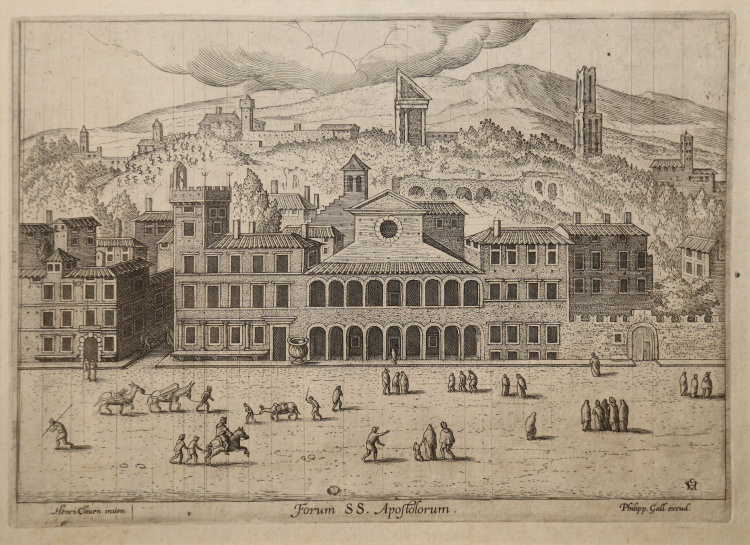



| Reference: | s3710 |
| Author | Hendrick van CLEEVE |
| Year: | 1587 |
| Zone: | Piazza SS. Apostoli |
| Printed: | Antwerpen |
| Measures: | 245 x 180 mm |


| Reference: | s3710 |
| Author | Hendrick van CLEEVE |
| Year: | 1587 |
| Zone: | Piazza SS. Apostoli |
| Printed: | Antwerpen |
| Measures: | 245 x 180 mm |
A nice view taken from the rare Ruinarum vari prospectus ruriumq. Aliquot delinationes.
Hendrick van Cleve or Cliven III, son and pupil of William van Cleve, moved to Italy in the second half of the XVI century; besides a painting depicting a view of Rome (1550), he realized a considerable amount of drawing which he afterwards used as preparatory for the engravings he realized in Antwerp and published by Philip Galle in 1587.
The views, whose main subject is Rome but there are also other European cities, bear the inscription “Henri. Cliven. inven" or "Henri Cliven pingebat" on lower part, which testify their origin, but not necessarily the fact that he realized them.
It is certain that Hendrick travelled to Italy. Scholars disagree about the timing of his stay in Italy. Some place it before 1551, the year in which he became a master of the Guild, while others place it between 1551 and 1555, the date on which he got married. In Italy he made many drawings of mountain views, buildings and cityscapes, which he later used in his works. Based on his known drawings of Italian cities, he likely spent time in Rome, Florence and Naples.
Hendrick van Cleve was a landscape artist. He created topographical views as well as imaginary landscapes. His landscapes are in the Italianising style and typically depict wide views with ruins that may or may not be entirely imaginary. The ruins are usually a compilation of characteristic elements from classical architecture. Some are based on existing ruins which can be identified. Others are completely fabricated constructions
Hendrik van Cleve's drawings were used by contemporary printmakers in Antwerp as designs. Two series of prints after van Cleve's designs were published by the renowned engraver and publisher, Philips Galle. The first series, Regionem, rurium, fundormumq[ue], varii atove amoeni prospectus was published in 1587. It consists of 10 plates that mainly depict imaginary pastoral landscapes with ruins. Hendrik van Cleve is mentioned as the designer on each print and Philip Galle as the engraver. The second series entitled Ruinarum varii prospectus, ruriumq[ue] aliquot delineationes is undated but was likely published around the same time as the first one. The 38 prints show Mediterranean views. It is not clear who engraved this series.
H. van Cleve's signature and monogram appear on all 38 engravings with the exception of engraving n.22 of the set which lacks the monogram. Philip Galle's signature also appears on all the engravings while that of his son Theodoor appears on engraving only. Hendrick van Cleve III may also have been the engraver as his monogram is present on the print.
Engraving, with fine later hand colour, some paper fold perfectly restored, otherwise good conditions.
|
Hollstein, F. W. H. Dutch and Flemish Etchings, Engravings, and Woodcuts, v.4, pl.170, n.1-38 and v.7, p.80, n.423-460.
|
Hendrick van CLEEVE (Anversa 1524 - 1589)
|
Son of Willem and brother of the painter Marten, Hendrick Van Cleeve, painter and engraver, was trained in Flemish master Frans Floris’s establishemnt. Following the example of other Flemish artists, Van Cleev made a trip to Italy, particularly to Rome, where he completed his education. He had the chance to draw from life views, landscapes and ruins that he later on used as preparatory drawings for his paintings, as recorded in 1621. Van Mander states that Van Cleev, apart from his early notes, used Melchior Lorch’s sketches to realize his views. His set of works is still debated and unclear for he signed only the 38-sheets series "RUINARUM VARI PROSPECTUS RURIUMQ. ALIQUOT DELINEATIONES", and the 12 plates of " Regionum rurium, fundorumque, varii amoeni prospectus", both issued by the Antwerp publisher Philip Galle (Haarlem 1537 - Antwerp 1618).
|
|
Hollstein, F. W. H. Dutch and Flemish Etchings, Engravings, and Woodcuts, v.4, pl.170, n.1-38 and v.7, p.80, n.423-460.
|
Hendrick van CLEEVE (Anversa 1524 - 1589)
|
Son of Willem and brother of the painter Marten, Hendrick Van Cleeve, painter and engraver, was trained in Flemish master Frans Floris’s establishemnt. Following the example of other Flemish artists, Van Cleev made a trip to Italy, particularly to Rome, where he completed his education. He had the chance to draw from life views, landscapes and ruins that he later on used as preparatory drawings for his paintings, as recorded in 1621. Van Mander states that Van Cleev, apart from his early notes, used Melchior Lorch’s sketches to realize his views. His set of works is still debated and unclear for he signed only the 38-sheets series "RUINARUM VARI PROSPECTUS RURIUMQ. ALIQUOT DELINEATIONES", and the 12 plates of " Regionum rurium, fundorumque, varii amoeni prospectus", both issued by the Antwerp publisher Philip Galle (Haarlem 1537 - Antwerp 1618).
|